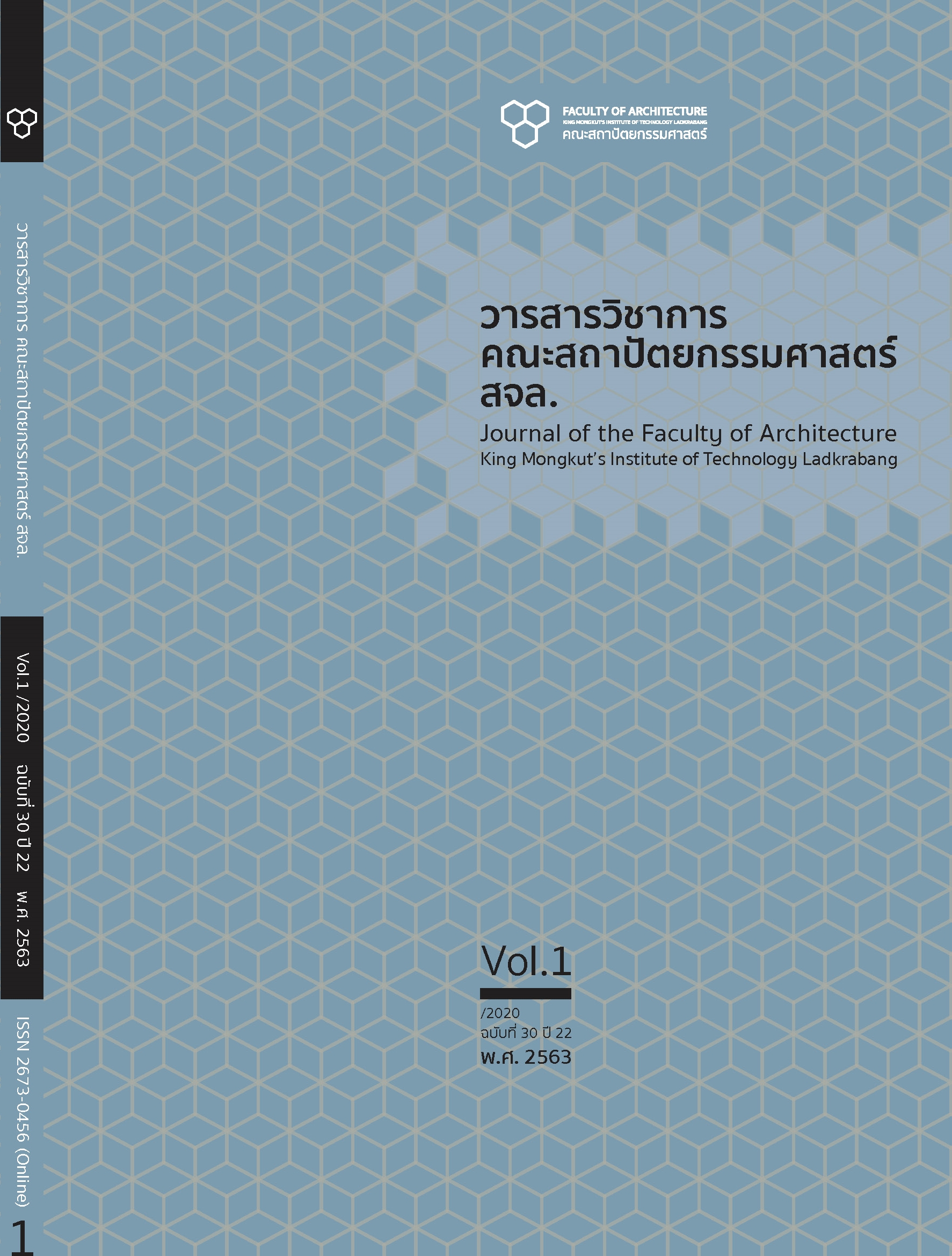The Exploratory and Data Research of Perennial Trees at Faculty of Architecture, King Mongkut’s Institute of Technology Ladkrabang for Conservation
Main Article Content
Abstract
The aim of collecting survey data and plotting coordinates of perennial plants at Faculty of Architecture King Mongkut's Institute of Technology Ladkrabang is to fulfill the royal initiative under the Plant Genetic Conservation Project Under the Royal Initiation of Her Royal Highness Princess Maha Chakri Sirindhorn initiative by King Mongkut's Institute of Technology Ladkrabang (RSPG-KMITL). The research objectives are 1) to compile plant species, 2) to plot coordinates of the plant species in the study area and 3) to train on plant survey methods and assess the satisfaction of students participating. The survey method divides the survey area of 85 rai (136,090 m2) into 4 parts for convenience by using the inner faculty's road as the boundary line. This study specifically focuses on perennial plants, which have the sizes of trunk circumference from 14.14 cm. at the height of 1.30 meters from the ground by recording the circumference of the trunk, the radius of the bush and the actual height of tree in meters. After that the plant co-ordinations were created by using computer drawing program to specify the position in the map. The survey process started from December 1, 2017- November 30, 2018. Additionally, the results identified that there are 2,301 trees, classified as 157 species, 121 genera, and 45 families. In brief, from the survey area, most species from the survey and the distribution of plant species in the study area are Tabebuia rosea (Bertol.) DC., Cerbera odollam Gaertn, Parkia javanica Merr., Dipterocarpus alatus Roxb., Swietenia mahogany (L.) Jacq., Swietenia macrophylla King., Samanea saman (Jacq.) Merr., Delonix regia (BoJ. ex Hook.) Raf., and Lagerstroemia floribunda Jack. Furthermore, this study finds 18 plants used for construction and 30 species of trees that have economic value from 58 items. As a result, the finding of this survey and mapping can be used and applied for further studies in landscape architecture and architecture. Besides, the authors organized a training course on plant species survey for students and received very satisfied results. This could lead to a participatory process for the conservations of plant for students.
Keywords: Plant Species, Perennial Plant, Finding Coordinates, Girth at Breast Height, Database
Article Details
This work is licensed under a Creative Commons Attribution-NonCommercial-ShareAlike 4.0 International License.
Copyright Transfer Statement
The copyright of this article is transferred to Journal of The Faculty of Architecture King Mongkut's Institute of Technology Ladkrabang with effect if and when the article is accepted for publication. The copyright transfer covers the exclusive right to reproduce and distribute the article, including reprints, translations, photographic reproductions, electronic form (offline, online) or any other reproductions of similar nature.
The author warrants that this contribution is original and that he/she has full power to make this grant. The author signs for and accepts responsibility for releasing this material on behalf of any and all co-authors.
References
กมลรัตน์ วงศ์รักษา. (2553). ความหลากชนิดของพรรณไม้ยืนต้นที่มีมูลค่าทางเศรษฐกิจ บริเวณสวนร่มเกล้ากาลพฤกษ์ มหาวิทยาลัยขอนแก่น. เข้าถึงได้จาก: https://kruvijai.wordpress.com/loaddockruvijai/article53/.
คณะกรรมการขับเคลื่อนการใช้ประโยชน์ที่ดินด้านเกษตรกรรมในพื้นที่กรุงเทพมหานคร. (2557). มาตรการบริหารจัดการ พื้นที่ เกษตรกรรมกรุงเทพมหานคร. เข้าถึงได้จาก: http://www.bangkok.doae.go.th/ag/zoning/map.pdf.
ไซมอน การ์ดเนอร์, พินดา สิทธิสุนทร และ วิไลวรรณ อนุสารสุนทร. (2549). ต้นไม้เมืองเหนือ: คู่มือศึกษาพรรณไม้ยืนต้น ในป่าภาคเหนือประเทศไทย. กรุงเทพฯ: ศูนย์หนังสือจุฬาลงกรณ์มหาวิทยาลัย.
ดารณี ด่านวันดี และ เกรียงศักดิ์ ศรีเงินยวง. (2559) การสำรวจพรรณไม้ในภาควิชาภูมิทัศน์และอนุรักษ์สิ่งแวดล้อมเพื่อ บูรณาการการเรียนการสอน. คณะสถาปัตยกรรมศาสตร์และการออกแบบสิ่งแวดล้อม มหาวิทยาลัยแม่โจ้, จังหวัดเชียงใหม่. เข้าถึงได้จาก: http://www.faed.mju.ac.th/download/storage/08-12/145.
เต็ม สมิตินันท์. (2544). ชื่อพรรณไม้แห่งประเทศไทย. กรุงเทพฯ: บริษัทประชาชน จำกัด.
ภาควิชาชีววิทยาป่าไม้ คณะวนศาสตร์ มหาวิทยาลัยเกษตรศาสตร์. (2559). บทที่ 2 สังคมพืชและลักษณะของสังคม. เข้าถึงได้จาก: http://cyberlab.lh1.ku.ac.th/elearn/faculty/forest/fo22/chap2/c2-1.htm.
ภาณุวัฒน์ ประเสริฐพงษ์. (2549). วิธีการศึกษามวลชีวภาพในป่า. เข้าถึงได้จาก: https://www.op.mahidol.ac.th/oppe/img/sus-meeting/18082558-4-วิธีการศึกษามวลชีวภาพในป่าไม้.
ราชกิจจานุเบกษา. (2558). พระราชบัญญัติ สวนป่า (ฉบับที่ 2) พ.ศ.2558. เข้าถึงได้จาก: https://library2.parliament.go.th/giventake/content_nla2557/law44-260558-1.pdf.
วันสต๊อกโฮม. (2561). ไม้สำหรับการก่อสร้าง. เข้าถึงได้จาก: https://www.onestockhome.com/th/knowledge/ structure-wood.
ศุภกาญจน์ เรืองวิริยะนันท์ และ ธนพรรณ กุลจันทร์. (2559). ฐานข้อมูลพรรณไม้ในมหาวิทยาลัยเชียงใหม่. วารสารสารสนเทศศาสตร์. 34(3), 21-38.
สมชญา ศรีธรรม. (2559). การเปรียบเทียบความหลากชนิดของไม้ต้นและการใช้ประโยชน์ในท้องถิ่นระหว่างป่ายางชุมและป่า ระหาร อำเภอเมืองสุรินทร์ จังหวัดสุรินทร์. วารสารเกษตรวรุณ. 13(1), 14-25.
สำนักวิจัยการอนุรักษ์ป่าไม้และพันธุ์พืช. (2554). คู่มือการสำรวจความหลากหลายของพรรณไม้. กรุงเทพฯ: กรมอุทยาน- แห่งชาติสัตว์ป่าและพันธุ์พืช.
อิงอร ไชยเยศ. (2556). 91463 ระบบสารสนเทศและการวิจัยเพื่อการจัดการทรัพยากรป่าไม้และสิ่งแวดล้อม หน่วยที่ 7 การสำรวจทรัพยากรป่าไม้. นนทบุรี: ศูนย์หนังสือมหาวิทยาลัยสุโขทัยธรรมาธิราช.
Google Maps. (2018, September 10). คณะสถาปัตยกรรมศาสตร์ สถาบันเทคโนโลยีพระจอมเกล้าเจ้าคุณทหาร- ลาดกระบัง. เข้าถึงได้จาก: https://www.google.com/maps/place/KMITL+Faculty+of+Architecture.
Tansley, A.G. (1939). The British Island and their Vegetation. 2nd ed. Cambridge: University Press.

